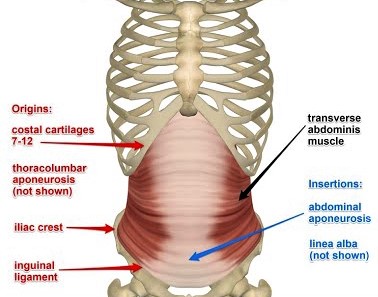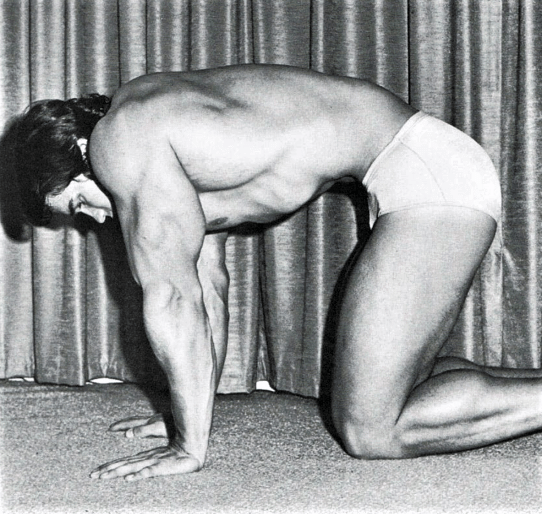Classic Physique Mr. Olympia Chris Bumstead vacuums. / Instagram
The stomach vacuum was more popular a half-century ago than now, both in gyms and on bodybuilding stages. That’s unfortunate. And it explains the name, which sounds like a digestive surgery. Ab vacuum would be more accurate, because “stomach” is no longer a synonym for waistline. The vacuum pose, in which the waist is hollowed out during a biceps or ab shot, was once a staple of bodybuilding contests, performed by Mr. Olympias Arnold Schwarzenegger and Frank Zane, among many other muscular men and women. They were able to hit that pose so effectively because they practiced it by regularly doing vacuuming their inner abs. It may be making a comeback, thanks to the popularity of the classic physique division its Olympia champ, Chris Bumstead, an excellent vacuumer.
Let’s hope so. We’re going to explain why everyone should be vacuuming frequently and how to correctly perform the stomach vacuum exercise.

STOMACH VACUUM & THE TRANSVERSE ABDOMINIS
The stomach vacuum is an isometric contraction of the transverse abdominis, the deepest abs. The transverse (or transversus) abdominis is a band of muscle that rests around your abdomen, beneath your rectus abdominis (six-pack muscles) and obliques (side muscles). Think of it as a corset. The main roles of the transverse abdominis are supporting the internal organs, protecting the spine, and helping you eliminate things in the bathroom.

Out of sight, out of mind: You may have never heard of it before, but the transverse abdominis is crucial to maintaining a slim waistline. Let it go lax and your gut spills forward. Pull it in and your waist is instantly smaller. Even many people who train the rectus abs regularly with leg raises, crunches, etc., neglect their inner abs and suffer from extended guts. (This happens with age, but it’s also a problem for those abusing growth hormone, because GH expands inner organs, too, leading to the dreaded “GH gut.”) By performing the stomach vacuum, you become aware of your inner abs and learn how to tense this “corset” during exercises like the squat and deadlift to better protect and strengthen your core. Meanwhile, working your inner abs reminds you to keep your waist in and not out all day long; and with stronger inner ab muscles it becomes easier to do this, too.
STOMACH VACUUM EXERCISE: HOW TO DO IT
1. Breathe in deeply through your nose and slowly exhale out your mouth. As you exhale, draw in your lower abdomen.
2. Feel your transverse abdominis contracting. You can place your fingers on your lower abs to better feel this movement.
3. Imagine your belly button being pulled towards the back of your spine.
4. Breathe normally but shallowly through your nose as you hold your waist in.
5. Hold this position for 20–60 seconds, building up to the one-minute mark over time.
6. The stomach vacuum can be done in any position (sitting, standing, lying, kneeling) and anywhere. In fact, it’s useful to do it at various times throughout the day, such as when sitting at your desk or in your car or standing in a checkout line. Get used to pulling in your abs and isometrically holding in different situations.
7. The stomach vacuum can also be done during some other ab exercises, such as the plank.
STOMACH VACUUM EXERCISE: ARNOLD’S ADVICE
Arnold Schwarzenegger is a big advocate of the stomach vacuum both as an exercise and as a bodybuilding pose. He offered this vacuum training advice:

“Following is an exercise I would regularly perform to improve my vacuuming ability. First, bend at the waist and support your upper body. Now, take in a deep breath of air and then blow it out forcefully. With your lungs devoid of air, pull your abdominal column in, as if you’re trying to touch your navel to your spine. Feel the way your whole midsection becomes inverted. It will be an awkward sensation at first, as if your muscles are turning inside out, which, in a sense, they are. However, after practicing this movement a few times, you will find that your abs begin to set into a ‘groove’ and that it becomes progressively easier each time you attempt to do it.”
STOMACH VACUUM: FAQS
Does vacuum exercise flatten stomach?
It helps. It strengthens the transverse abdominis (inner ab wall), which keeps your gut in. But if you have a lot of body fat outside your abs, you still won’t have a flat stomach.
Can doing the stomach vacuum reduce belly fat?
No. Only diet and cardio exercise will reduce belly fat.
How many stomach vacuums should I do per day?
You can do them several times per day and throughout the day. Five to 10 times is a good number to shoot for.
How long does it take for a stomach vacuum to work?
As with any muscle, you should see significant strength increases within 4-6 weeks.
Do stomach vacuums help with anything?
Yes, it strengthens the transverse abdominis, and also reminds you to hold your waist in for maximum core strength, proper posture, and a slimmer waist.
Does holding your stomach in make it flat?
Not by itself. But it will help.
How does your stomach get flatter?
Lose body fat from diet and cardio and strengthen your abdominals (including the transverse abdominis).
Can you do stomach vacuums every day?
Like any muscle, it will take time to recover. We recommend doing vacuums no more frequently than any other day.
Do vacuums reduce waist size?
They help by strengthening your inner abs and reminding you to keep your waist pulled in.
How long should you do stomach vacuums?
20-60 seconds.
Should stomach vacuums be done on an empty stomach?
They don’t have to be done on an empty stomach, but you’ll find you can pull the vacuum in further with an empty versus a full stomach.
















































